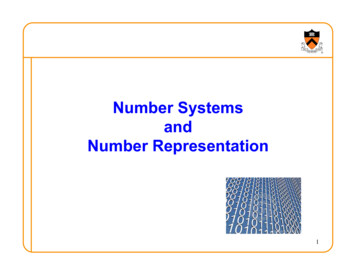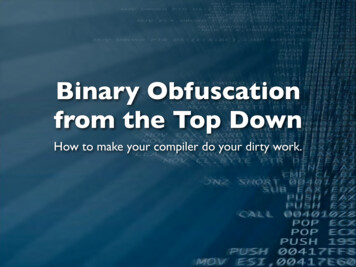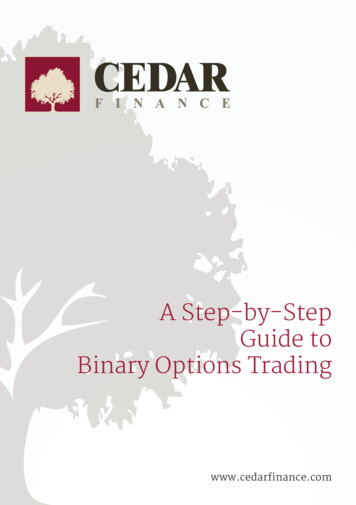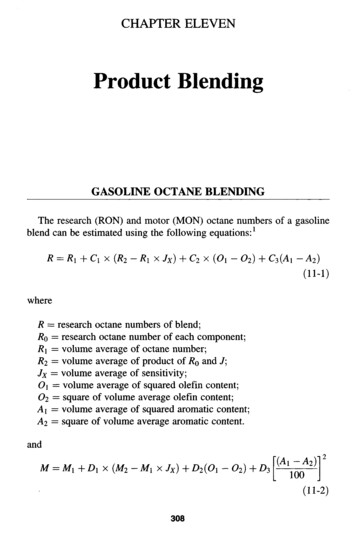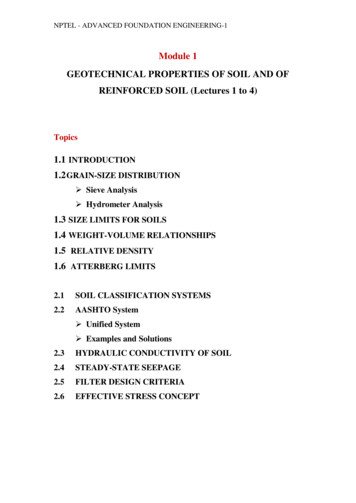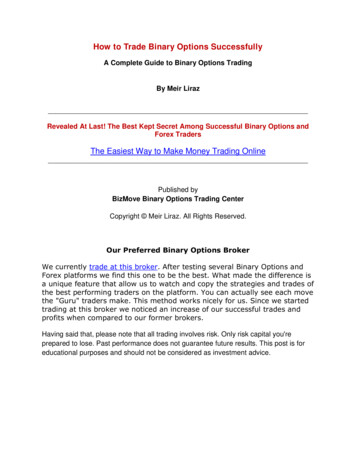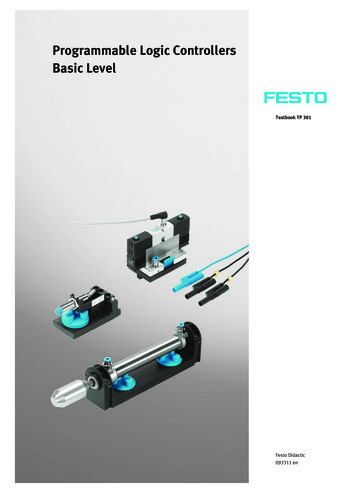![Practical Fine-Grained Binary Code Randomization[2]](/img/19/acsac20.jpg)
Transcription
Practical Fine-Grained Binary Code Randomization†Soumyakant PriyadarshanHuan NguyenR. SekarStony Brook University, USAspriyadarsha@cs.stonybrook.eduStony Brook University, USAhnnguyen@cs.stonybrook.eduStony Brook University, USAsekar@cs.stonybrook.eduAbstractDespite its effectiveness against code reuse attacks, fine-grainedcode randomization has not been deployed widely due to compatibility as well as performance concerns. Previous techniques oftenneeded source code access to achieve good performance, but thisbreaks compatibility with today’s binary-based software distribution and update mechanisms. Moreover, previous techniques breakC exceptions and stack tracing, which are crucial for practical deployment. In this paper, we first propose a new, tunable randomization technique called LLR(k) that is compatible with these features.Since the metadata needed to support exceptions/stack-tracing canreveal considerable information about code layout, we propose anew entropy metric that accounts for leaks of this metadata. Wethen present a novel metadata reduction technique to significantlyincrease entropy without degrading exception handling. This enablesLLR(k) to achieve strong entropy with a low overhead of 2.26%.ACM Reference Format:Soumyakant Priyadarshan, Huan Nguyen, and R. Sekar. 2020. Practical FineGrained Binary Code Randomization. In Annual Computer Security Applications Conference (ACSAC 2020), December 7–11, 2020, Austin, USA. ACM,New York, NY, USA, 14 pages. onWith widespread adoption of data execution prevention (DEP) onmodern operating systems, attackers have shifted their focus fromcode injection to code reuse attacks, e.g., return-oriented programming (ROP) [47] and jump-oriented programming (JOP) [7]. Existing defenses against code reuse attacks fall into two broad categories: control-flow integrity (CFI) [2, 15, 36, 52, 61, 64] and finegrained code randomization [6, 11, 14, 16, 18, 26, 30, 31, 38, 55, 57,62]. Although the deterministic nature of CFI is attractive, as acode-reuse defense, CFI has a few drawbacks: Use of CFI-permitted gadgets: With CFI, attackers are unconstrained if they target “legitimate gadgets,” i.e., gadgets that arereachable as per the policy enforced by CFI. In contrast, finegrained code randomization hides the location of every gadget,thus requiring extra work (e.g., information leaks) before any ofthem can be used in an attack.Permission to make digital or hard copies of all or part of this work for personal orclassroom use is granted without fee provided that copies are not made or distributedfor profit or commercial advantage and that copies bear this notice and the full citationon the first page. Copyrights for components of this work owned by others than theauthor(s) must be honored. Abstracting with credit is permitted. To copy otherwise, orrepublish, to post on servers or to redistribute to lists, requires prior specific permissionand/or a fee. Request permissions from permissions@acm.org.ACSAC 2020, December 7–11, 2020, Austin, USA 2020 Copyright held by the owner/author(s). Publication rights licensed to ACM.ACM ISBN 978-1-4503-8858-0/20/12. . . 15.00https://doi.org/10.1145/3427228.3427292 Lack of graceful degradation: If CFI instrumentation leaves outsome modules or code fragments, attackers can initiate a ROP attack from these fragments. Once initiated, such an attack is freeto use unintended gadgets anywhere, including modules thathave the CFI instrumentation. This is because CFI checks areapplied only on legitimate instructions, e.g., intended returns,rather than unintended ones1 . This contrasts with randomization, where weaknesses introduced by an unrandomized codemodule are limited to the gadgets within that module. Compatibility: Higher precision (aka fine-grained) CFI [15, 36,52] suffers from compatibility problems on complex code. Coarsegrained CFI [1, 2, 61, 64] poses fewer compatibility challenges,but is more easily defeated. Code randomization typically facesfar fewer compatibility problems than CFI techniques.These factors have prompted substantial research on fine-grainedcode randomization. Early works [6, 30] targeted the static ROPthreat model, where the attacker has a copy of the victim’s binarycode. By statically analyzing this code, he/she can identify gadgetsthat can be used in an attack. Code reuse attacks have since evolvedto use dynamic probing of victim process code and/or data memoryby leveraging memory disclosure vulnerabilities: (Direct) JIT-ROP attacks [50] rely on the identification of gadgetson the fly by disclosing victim’s code memory. Indirect disclosure ROP attacks leak just the data memory —specifically, code pointers stored in data memory.Like many recent works, we rely on execute-only code for thwartingdirect JIT-ROP. The new techniques developed in this paper are thusaimed at the static ROP and indirect disclosure ROP threat models.1.1Motivation: Deployable Code RandomizationDespite advances in new code randomization techniques, they arenot widely deployed due to several concerns described below.Need for Source Code. Many code randomization techniquesrely on a modified compiler [6, 14, 31] or special compiler options[18, 30, 57] (e.g., debug or relocation flags) that aren’t enabled onproduction binaries. This makes them incompatible with today’sdominant software deployment and update mechanisms, whichinvolve the distribution of binary code. Even open-source softwareis predominantly distributed in binary format for convenience.Performance. A low overhead is critical for the deployment ofsecurity hardening measures. Often, a 5% or lower threshold isquoted. While techniques that rely on some level of compiler support [14, 18, 30, 31, 57] have met this threshold, most binary-basedtechniques (e.g., [16, 26, 62]) tend to have higher overheads.1 Theattacker can use any gadget beginning in the middle of a legitimate instruction,as long as the indirect control flow instructions in the gadget are unintended.† The first two authors contributed equally to this work, which was supported by ONR(N00014-17-1-2891). Third author’s work was also supported by NSF (CNS-1918667).
ACSAC 2020, December 7–11, 2020, Austin, USACompatibility with stack tracing and C exceptions. A chiefconcern for deployed software is the support for error handling andreporting. Unfortunately, existing fine-grained code randomizationtechniques don’t support these features. While this incompatibilitymay be acceptable for a proof-of-concept implementation, it is not aviable option for platform-wide deployment. In particular, librariesneed to be compatible, or else exceptions and stack traces are brokenfor every application that uses them.Some techniques (e.g., Readactor [14]) are incompatible becausethey violate a key assumption behind these mechanisms: that function bodies are contiguous. Many others [6, 11, 16, 18, 26, 30, 55,57, 62] are incompatible because they fail to maintain the metadataused by these mechanisms. More importantly, none of the previous techniques have considered the security implications ofthis metadata. In particular, both stack tracing and exception handling operate from the “stack unwinding” information stored inthe eh frame section of Linux binaries. This section records theaddresses of the first and last instructions of (almost) every functionin the binary. It is important to note that this information is presentin stripped binaries, and is stored in readable memory at runtime.Moreover, this information is not limited to C , as stack tracesare needed for C-code as well. We found that this information ispresent for 95% of the code on Ubuntu Linux.Since attackers have proven adept at leaking information storedin readable memory, it is necessary to develop randomization techniques that are secure despite such leaks. In particular, many existing techniques derive the bulk of their randomness from permutingthe order of functions. The availability of eh frame informationdefeats the security of such schemes.1.2Approach Overview and ContributionsIn this paper, we present Stony Brook Static Binary Randomizer(SBR) that provides the following key features: Compatibility with exceptions and stack traces; Compatibility with COTS binaries, including low-level librariessuch as the system loader (ld) and the C-library (glibc); Support for code written in multiple languages, including C,C , Fortran and hand-written assembly, and compiled usingmultiple compilers (e.g., gcc, llvm and gfortran); and Low runtime overhead.SBR has been tested on 640MB of binaries. (This is about 2/3rdthe size of all binaries on Ubuntu Desktop 18.04.) We plan to opensource SBR in a few months. Our main contributions are as follows.Stack-unwinding-compatible randomization. We present anew technique called LLR(k) that provides the following benefits: Each leaked code pointer reveals the locations of just 𝑘 moreinstructions. As a result, attackers need to leak many pointersbefore they have sufficient gadgets for an effective payload. Users can easily make security vs performance trade-offs by tuning 𝑘. Larger 𝑘 values yield better performance, while smaller 𝑘values offer increased security. Moreover, LLR(k) can be seamlessly combined with other randomization techniques. Our experimental results show that 𝑘 16 achieves good security (in the form of high entropy) with a low overhead of 2.26%.Soumyakant Priyadarshan, Huan Nguyen, and R. SekarUnwinding Block Entropy and Reduced EH-Metadata. Weshow that the metadata used for C exceptions and stack-tracingreveals a lot of fine-grained information about instruction locations. We define a new entropy metric, unwinding block entropy, toquantify the difficulty of attacks that exploit this metadata. We develop a novel approach for reducing the metadata suchthat C exceptions would continue to work seamlessly, andwith the same performance as before. We show that this metadata reduction has a major impact onour new entropy metric, increasing it by 8x.Comparison of randomizing transformations. We present arobust implementation of SBR that scales to complex binaries on 64bit x86/Linux systems. It randomizes all code, including executablesand all libraries. Using this implementation, we present a detailedexperimental evaluation of the security vs performance trade-offoffered by previous randomization techniques and our new LLR(k).1.3Paper OrganizationSec. 2 provides the background on stack unwinding, our threatmodel, and previous randomization techniques. Our new LLR(k)technique is introduced in Sec. 3. A new unwinding metadata optimization is described in Sec. 4. Our new entropy metrics are presented in Sec. 5, followed by our binary instrumentation approachin Sec. 6. Implementation and evaluation are the topics of Sec. 7 and8, followed by discussion, related work, and conclusions in Sec. 9,10 and 11.22.1Background and Threat ModelC Exception and Stack Tracing CompatibilityModern C compilers and runtime systems implement a “zerooverhead” (aka “zero cost”) exception model. This model is aimedat eliminating runtime overheads for any program that raises noexceptions, even if it includes code that uses exceptions. This isachieved by avoiding proactive book-keeping at runtime for exception handling. Instead, the compiler generates tables that includeall the information necessary to process exceptions at runtime. Thistable is stored in read-only data sections in the binary that we willcollectively refer to as EH-metadata.On GNU/Linux, stack tracing also uses EH-metadata, so thismetadata is included in code generated from many languages, including C. Even hand-written assembly in many system librariescontains EH-metadata. The vast majority of binary code on Linuxsystems is covered by EH-metadata — for instance, 95% of all thecode in /bin and /lib/x86 64-linux-gnu on Ubuntu 18.04 Linux.An operation central to exception processing as well as stacktracing is stack unwinding. This operation involves restoring thevalues of callee-saved registers, and restoring the stack pointer toits value when the current function was entered. On completionof unwinding, the stage is set for returning to the caller. The callermay in turn perform its own unwinding and return to its caller, andso on. For C programs, unwinding stops when it reaches a catchblock for the current exception, or the outermost stack frame.EH-metadata specifies: (a) the start and end locations of eachfunction, (b) the beginning and end of each unwinding block, and (c)
Practical Fine-Grained Binary Code Randomizationthe operations for unwinding. An unwinding block may correspondto a try-block in a C program, or to instructions that changethe stack pointer and/or callee-saved registers. The operations forunwinding a block are usually specified as a delta over a previousunwinding block, thus revealing dependencies between them. Moredetails on EH-metadata can be found in [37, 42].Key Implications and Requirements for Code Randomization. Exception metadata needs to be updated after code movement. This metadata reveals a lot of information useful to attackers:(1) the start and end address of each function,(2) the start and end of each unwinding block, and(3) the dependence between unwinding blocks.Our investigation shows that across a range of Linux/x86 64 binaries, an average function contains about a dozen unwindingblocks. So, unless care is taken, EH-metadata can leak a lot ofinformation about code locations, thereby greatly degrading theeffectiveness of code randomization. To address this threat, we need new code randomization techniques that can provide adequatesecurity despite such leaks (Sec. 3), new metadata optimization techniques that minimize the amountof EH-metadata without impacting the functionality or performance of exception handling (Sec. 4), and new entropy metrics that assess the security provided by coderandomization in the face of EH-metadata leaks (Sec. 5).2.2Threat Model and Security GoalsOur threat model is similar to previous work, with the key differencethat attackers are aware of SBR’s compatibility with stack tracesand exceptions and hence may: leverage the fact that function bodies are contiguous in order tospeed up their attack, and/or target EH-metadata specifically and disclose it. This is possiblebecause this metadata is present in stripped binaries, and is storedin readable memory at runtime. Moreover, it typically covers 95%of all functions, including most C-code and assembly.With these differences in mind, we outline the three threat modelsconsidered in code randomization research.Static ROP. Although this threat model mentions ROP [47] specifically, it is intended to include other code reuse attacks that rely onexisting code snippets such as JOP [7]. This threat model assumesthat (a) the attacker is able to exploit a vulnerability in the victimprogram to hijack its control flow to start the execution of a gadgetchain, and (b) the locations of these gadgets are determined onthe basis of an attacker’s prior knowledge of the victim program’sbinary. All code randomization techniques aim to take away (b),but don’t always do it completely. For instance, compiler-basedtechniques don’t randomize low-level code written in assembly.Our goal is to defeat static ROP by ensuring that the attackerhas no knowledge of any part of the binary code that executes atruntime, and by introducing large entropy into this binary.JIT-ROP. The JIT-ROP threat model assumes that the victim program has a memory corruption vulnerability that provides (i) anarbitrary read capability, and (ii) an ability to hijack control-flow.ACSAC 2020, December 7–11, 2020, Austin, USAIt also assumes the availability of a scripting environment that (i)executes attacker-provided scripts, and (ii) can exercise these vulnerabilities. State-of-art defense against JIT-ROP relies on executeonly (i.e., non-readable) code. Since this technique imposes verylow overheads and is also very strong due to its reliance on hardware memory protection, our approach will simply rely on thistechnique to protect against JIT-ROP. (Note that our techniques arecompatible with execute-only code.)Indirect (only) Disclosure ROP. This threat model assumes thatthe victim program has a memory corruption vulnerability that enables an attacker to read arbitrary memory locations. It also assumesthe availability of another vulnerability that enables control-flowhijack. Finally, it assumes that code is protected from reads, so theattacker cannot use leaked pointers to search the code for usablegadgets. Instead, she targets gadgets that are adjacent to the leakedcode address, or at a short distance from it.Attackers may very well use gadgets at the leaked pointers. Preventing such reuse is hard, and is outside the scope of code randomization. Instead, our goal is to prevent attackers from using leakedpointers to identify (the locations of) additional usable gadgets.The availability of EH-metadata greatly increases useful information that may be leaked by indirect disclosures.2.3Common Randomizing TransformationsIn this section, we summarize most of the fine-grained randomizingtransformations that have been proposed before. These transformations proceed in two phases. The first phase determines how afunction body is split into a set of partitions. In the second phase,the partitions are permuted, and jumps introduced as needed topreserve the original control-flow. Since the second phase is similarfor all transformations, we focus on the first phase below. Function Reordering (FR): Proposed in the earliest works oncode randomization [6, 30], this technique does not changefunction bodies at all — it simply permutes the order of functionsin the code section. This achieves high entropy against staticROP threat model, but FR is insufficient if code pointers or stackunwinding information can be leaked. ZeroJmp (ZJR): Koo et al [31] proposed to align code splits at locations terminating with unconditional jump instructions. Withthis alignment, no new jumps are introduced for randomization;instead, we simply adjust the targets of existing jumps afterpermuting the blocks. As a result, Koo et al achieved nearlyzero overhead for this technique. We show, however, that ZJR isrelatively weak against adversaries that can leak code pointers. Basic Block Randomization (BBR): This technique splits function bodies at basic block boundaries. A basic block is an instruction sequence with no incoming control transfers exceptto the first instruction, and no outgoing control transfers exceptthrough the last instruction. Pointer-Hiding Randomization (PHR): Readactor [14] introduced a pointer hiding defense against indirect disclosure attacks.Specifically, for every indirectly called function, they introducea corresponding trampoline that then jumps to that function. Itis only the trampoline address that is stored in memory. Sincethe trampoline is located randomly, it reveals no information
ACSAC 2020, December 7–11, 2020, Austin, USAabout possible gadgets at the beginning of the target functions.To protect return addresses, each call is replaced with a jumpto a trampoline for that call-site, with the trampoline making acall to the target function. As a result, the return address onlyleaks the location of the trampoline.Random placement of call-site trampolines will break stackunwinding. So, we consider a modification of Readactor’s technique that locates the trampoline at a random location within thebody of the caller. In addition, code blocks between successivecalls are permuted. We call this variant as PHR. Phantom Blocks (PB): Instead of relying purely on permutation,phantom blocks were introduced in kRbX [40] to create gapsbetween blocks of original code. By randomly varying the sizeof phantom blocks, entropy can be further increased. Moreover,these blocks can be made into “traps” by filling them with invalidcode. This will cause any jumps into these blocks to terminatethe victim program.Note that PB does not create new splits in the function body — instead, it relies on other schemes such as BBR or PHR. Specifically,kRbX relies on the PHR variant described next. One-side Pointer Hiding (OPHR): Note that call-site trampolines of PHR require one jump into the trampoline, and a secondjump out of the trampoline. Performance can be improved byremoving one of these jumps. There is also a security cost, because the gadget location are hidden only on one side of the call:the side that contains a jump.3LLR(𝑘): Length Limiting RandomizationExisting randomization techniques outlined above do not satisfactorily address indirect disclosure ROP that leverages EH-metadata: PHR can stop attackers from computing additional gadgets adjacent to a return address even after the attacker leaks thatreturn address. However, if the attacker leaks a code addressfrom EH-metadata, PHR cannot prevent attackers from knowingthe locations of nearby gadgets. ZJR and BBR don’t address indirect disclosures per se, but theydo have a secondary effect since they chop and permute function bodies. This means that a leaked return address exposesthe location of instructions in the same code block, but the gadgets in other blocks within the caller are still unknown to theattacker. Unfortunately, ZJR blocks can be large. In the SPECsuite, we observed thousands of blocks consisting of hundreds ofinstructions. Although BBR blocks tend to be small on average,there are still over a hundred blocks containing hundreds ofinstructions. In fact, we find a basic block that is 8KB-long! As aresult, a leaked code address can allow an attacker to computea large number of additional gadgets. PBs also don’t address indirect disclosures, so kRbX [40] relieson OPHR for this purpose. Being a weaker (but faster) form ofPHR, OPHR shares the weaknesses of PHR, i.e., no protection isoffered for addresses disclosed in the EH-metadata. In addition,OPHR shares a drawback of ZJR: that the number of large OPHRblocks is comparable to that of ZJR.In contrast, we introduce a new technique, called Length LimitingRandomization (LLR(k)), which limits the utility of any disclosedSoumyakant Priyadarshan, Huan Nguyen, and R. Sekarcode address. The basic idea behind LLR(k) is very simple. Let 𝑠be the size of a function. We generate 𝑝 ⌊𝑠/𝑘⌋ distinct randomnumbers 𝑟 1, .𝑟 𝑝 over the range [1, 𝑠 1]. We then proceed to createa partition at each 𝑟𝑖 . Since the number of partitions is 𝑝 1, theaverage partition size is 𝑠/(𝑝 1) 𝑠/(⌊𝑠/𝑘⌋ 1) 𝑠/(𝑠/𝑘) 𝑘.Despite its simplicity, LLR(k) is quite powerful, and offers severalbenefits over previous techniques: Tunable entropy and performance: Small values of 𝑘 mean a largenumber of small blocks. This increases entropy, but decreasesperformance because frequent jumps increase code size, whilealso decreasing cache locality. By the same reasoning, larger 𝑘values provide better performance while decreasing entropy. Bounded utility for any disclosed address. Since the expectedlength of any contiguous block of code is 𝑘, an attacker thatdiscloses an address can expect to be able to guess the locationsof up to 𝑘 adjacent instructions. To access gadgets beyond thisrange, the attacker will have to disclose additional addresses2 . Higher entropy than other techniques for the same number ofpartitions. For a given average partition size, LLR(k) providesmuch higher entropy as compared to other schemes such as ZJRor BBR. For instance, consider a function of size 100 instructions,and let the average block size be 10. For this block size, both ZJRand BBR yield an entropy of 22 bits, while LLR(k) yields 66 bitsof entropy! This is because LLR(k) introduces a lot of additionalrandomness in the placement of breaks, whereas the placementis deterministic for all other schemes discussed above. Can be seamlessly combined with other randomizations. We canstart with a base randomization scheme, such as ZJR, BBR, PHR,or OPHR, and introduce additional randomness using LLR(k).Suppose that the base scheme introduces breaks at 𝑚 1 locations, thus yielding 𝑚 partitions of a function. We then eliminatethese 𝑚 1 locations (out of a total of 𝑠 1 possible locations)from consideration, and number the remaining locations from 1to 𝑠 𝑚. From these 𝑠 𝑚 locations, we choose 𝑝 ⌊𝑠/𝑘⌋ 𝑚 random locations to create additional partitions. Note that the totalnumber of partitions is ⌊𝑠/𝑘⌋, thus ensuring the same averageblock size as a pure LLR(k) scheme.The most obvious combination is ZJR LLR(k). In practice, thereis no reason to omit ZJR since it has nearly zero overhead. So, wemake ZJR LLR(k) combination as the default, using the term LLR(k)to refer to this combination. Stand-alone LLR(k) is called pure-LLR(k).A second combination we consider is PHR LLR(k). As comparedto PHR, we show that it provides a substantially higher entropy ata small additional performance cost.4Limiting Disclosures in EH-metadataBy updating EH-metadata after code randomization, the functionality of C exceptions and stack tracing can be restored. Unfortunately, the updated metadata reveals far too much informationabout the new code layout that can be leveraged to defeat randomization. Recall from Sec. 2.1 that EH-metadata reveals:2 Since partitions are determined by a random number generator, some LLR(k) partitionscan be larger than 𝑘 . However, unlike randomization schemes where the attackerknows the larger blocks ahead of time, the attacker cannot predict which LLR(k) blockswill be large. This is why we consider the expected length 𝑘 as a limit on the numberof gadgets an attacker can determine from a disclosed address.
Practical Fine-Grained Binary Code Randomization(a) the start and end of each unwinding block,(b) the dependence between successive unwinding blocks, and(c) the operations for unwinding the stack and restoring registers.It is easy to see that the amount of metadata is directly proportionalto the number of unwinding blocks. Thus, in order to minimizedisclosures through EH-metadata, we describe in Sec. 4.1 our technique for eliminating most unwinding blocks without impactingexception handling. Next, in Sec. 4.2, we discuss the spectrum ofpossible code transformations that preserve unwinding compatibility for the remaining blocks, and justify our specific design choice.4.1ACSAC 2020, December 7–11, 2020, Austin, USAFunction100:push%rbp//Block 𝐴1102:sub 20,%rsp//Block 𝐴2106:push%r8//Block 𝐴3108:call 14010d:pop %r8//Block 𝐴410f: call 120114:add 20,%rsp//Block 𝐴5118:pop %rbp//Block 𝐴611a:retReducing EH-metadata Stored in MemoryA key observation we make is that small unwinding blocks frequently consist of instructions such as push or pop that won’ttrigger C exceptions. This is because C exceptions are ultimately triggered by a call to a throw function in the standard C library. This means that only those unwinding blocks that containcall instructions can be involved in a C exceptions. All otherunwinding blocks could only be used in stack tracing, which istypically used when a process terminates due to a fatal error. Thismay include the case of unhandled signals, e.g., due to memoryfaults, divide by zero, etc.Based on the above observation, our design generates two versions of EH-metadata: a full version that includes all unwindingblocks, and a reduced version that only stores information for callcontaining unwinding blocks. The full version is stored in a regionof memory that is made unreadable, so it cannot leak to the attacker.The reduced version is the EH-metadata that is available at runtime.When C exceptions occur, the above design ensures that ourreduced EH-metadata will include the information needed for unwinding all the code blocks in the current call chain. Consequently,exception handling will continue to work as before.Typically, stack tracing is invoked when a process encounters aserious error. Such an error may be detected by the program, andit may respond by calling a library function for printing the stacktrace and exiting; or, it may be an unhandled error that manifestsas a UNIX signal. In the former case, since a function is beinginvoked, all the relevant unwinding information will already be inthe reduced EH-metadata. To handle the latter case, we can installa signal handler in the instrumented binary to check if the erroris due to a fault triggered by an instruction execution. If so, SBRwill replace the reduced EH-metadata with the full version. Aftercompleting its task, SBR’s signal handler will transfer control to theapplication’s signal handler. This kind of signal handler “hooking”can be achieved by instrumenting glibc functions used for signalhandler registration. This is feasible since SBR instruments allbinaries, including glibc and the system loader. However, we havenot implemented this yet.Note that the above design can support C exceptions as wellstack tracing for programs written in C or other languages. We addno additional overheads for C exceptions, or any explicit calls tofunctions that perform stack-unwinding. There is additional overhead in the remaining cases, but since those cases typically occurin conjunction with process or thread termination, the additionaloverheads seem acceptable.Unwinding operations for original blocks𝐴1 [100-100]: RBP *(RSP); RSP RSP 8𝐴2 [102-102]: {RSP RSP 20} unwind operations of 𝐴1𝐴3 [106-108]: {R8 *(RSP); RSP RSP 8} unwind operations of 𝐴2𝐴4 [10d-10f]: unwinding operations of 𝐴2𝐴5 [114-114]: unwinding operations of 𝐴1𝐴6 [118-11a]: { };Unwinding operations post-optimization𝐴13 [100-108]: R8 *(RSP); RSP RSP 28;RBP *(RSP); RSP RSP 8𝐴46 [10d-11a]: RSP RSP 20;RBP *(RSP); RSP RSP 8Fig. 1: Unwinding blocks exampleFig. 1 illustrates our optimization on an example function with 6unwinding blocks, 𝐴1 through 𝐴6 . The second column in the figur
metadata is included in code generated from many languages, in-cluding C. Even hand-written assembly in many system libraries contains EH-metadata. The vast majority of binary code on Linux systems is covered by EH-metadata — for instance, 95% of all the code
